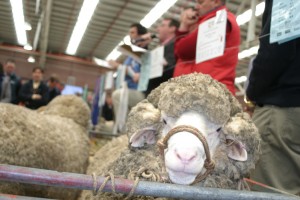
Top sale rams and show winners are being sought for the Merino Lifetime Productivity project.
YOUNG and old rams, show winners, sale toppers, trait or index leaders and just good doers are being sought for the 2017 ewe joining in the Merino Lifetime Productivity project.
MLP project manager Anne Ramsay said four sires have already been nominated for the MLP project and another 39 rams are being sought, including link rams, to meet the requirement for 13 rams for the MerinoLink site in New South Wales, 15 rams for the Pingelly site in Western Australia and 15 rams for the New England NSW site.
The MLP project is being managed by the Australian Merino Sire Evaluation Association and Australian Wool Innovation support of $450 per sire will cut the MLP entry fee for the sites to: MerinoLink $2900, Pingelly $2500 and New England about $2500.
Ms Ramsay said it was important to have a good representation of sires from across the industry to help bring the industry together from statistical and social perspectives.
“We are trying to make sure that we are representative of all of industry, and that we’ve got all of industry genetics represented in the trial.
“So that we can learn — no matter what breeding belief or what selection systems you use – what will help us to better predict lifetime,” she said.
“There have been some interesting rams that have won at shows this year and some rams that have sold for massive high prices.
“So you think what is it about those rams that is so attractive, can we get them in the project and have a look at them more closely?”
The MLP project is a platform for all Merino breeders to come together and share ideas and beliefs, and learn from each other, she said.
The participating MLP site rainfall and flock details are:
MerinoLink (Temora, NSW) 600mm, slight winter dominant rainfall, 18um flock average, previous sire evaluation progeny and from studs with Australian Sheep Breeding Values.
Pingelly (Pingelly, WA) 440mm, winter rainfall, 19.5um clock average, meaty Merino ewes.
New England (Armidale, NSW) 700mm+, summer dominant rainfall, 17um flock average, traditional ultra-fine flock.
The MerinoLink site currently plans to artificially inseminate ewes in the first week of January 2017 and semen will be required by December 10. The Pingelly ewes will be AI-joined in late January and the New England flock will be AI-mated in April.
MLP ewe progeny will be retained for annual joining, classing and lifetime assessment. Ninety ewes will be artificially inseminated to each sire to ensure that there will be sufficient ewe progeny numbers throughout the life of the project. Entrants at sites will receive a full range of visual and objective results including professional classer assessed performance, within site breeding values and ASBVs.
The sites will operate like a standard sire evaluation site – following the rigorous and independently assessed measured and visual assessment protocols. At the conclusion of the standard sire evaluation — generally once progeny are between 18 to 24 months of age — Australian Wool Innovation will support the ongoing measurement and visual classing of all ewe progeny through 4-5 joinings and annual shearings.
Annual field days will be held at sites for ram owners and the broader industry to inspect progeny, receive updates on the progress of the project and network with fellow Merino producers.
The nomination process is centralised in that all nomination forms will be sent through the MLP project manager Anne Ramsay. Once nominations close, sires will be profiled for their suitability to meet the projects sire selection criteria. The MLP project executive will then work with the relevant site committees and the project industry steering committee to generate the final sire list. More sire selection details can be found in the information package provided on the website.
Nomination forms and further details can be found on the MLP website www.wool.com/MLP with nominations closing 5pm October 28, 2016.
Ms Ramsay said the project had joined rams for the past two years at the Elders Balmoral Sire Evaluation Trial site fine wool flock, Tuloona at Harrow. She said it is hoped to have more sites in the project, possibly in north-east Victoria and in South Australia. There was also interest among Monaro breeders near Cooma, New South Wales.
Sources: AMSEA, AWI.

HAVE YOUR SAY